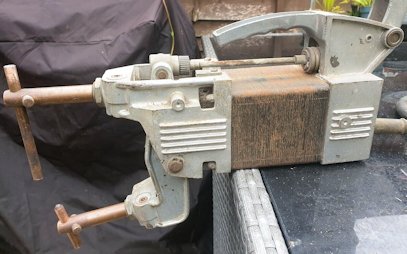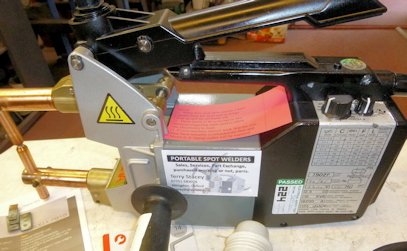Resistance spot welding How it works

Here we discuss the use of spot welding and how it works.
Spot welding is a variant of electric resistance welding and this method of assembly is used not only because of its technical advantages but also because of the important cost reduction that can be achieved.
The mass production of motor car bodies involves the use of spot welding and motor cars are held together by between 4000 and 9000 spot welds.
The advantages of spot welding are the following;
- Spot welding is the fastest, strongest and most reliable method of joining two pieces of sheet metal.
- Spot welding gives little or no metal distortion owing to too great radiation of heat; the heat required for making a spot weld is limited to a small area around it,
- In some cases it is possible to make spot welds which are almost invisible. This is especially valuable when welding more eye-catching parts.
- No preparatory work is needed for spot welding compared to bolting or riveting there is no need to drill metal, screw bolts drive rivets, and no need for electrode, oxygen or acetylene; hence there is a considerable cost reduction.
- Spot welding does not alter the mechanical characteristics of the parent metal. Good spot welds are equal in strength, hardness and ductility to the original specification of the sheet metal as laid down by the designer for its mechanical performance.
Although repair work is different from production, the repairer should be able to carry out work to standards of quality identical to those obtained in mass production and make use of the advantages offered by spot welding.

The principles of spot welding
A comparison can be made between an electrical spot weld and a forge weld for in both of these processes a union is formed by an amalgamation of the molecules. In the case of
forge welding, the metal pieces are heated in the forge furnace and then hammered until homogeneous. In the case of spot welding the pieces are heated electrically using the same principle as in an electric radiator (resistance effect); they are subjected to a certain pressure which must be sufficient and continuous to enable the molecules i.e. sub microscopically small particles, to interlock. Spot welding is a self-contained weld method on a limited surface area without added weldmetal.
It involves:
- The use of a preset pressure.
- An electric current of precise intensity and duration
A spot welding gun must have:
- A pressure device worked by the operator for transmitting the pressure to the electrodes.
- A transformer to enable current at high intensity to be fed to the electrodes.
These electrodes are made of a copper chrome alloy, selected for strength and good conductivity. The electrodes must have the ability to conduct mechanical and electrical power.
The following are the three stages in making a spot weld:
- Squeeze time
- Weld time (duration of current flow)
- Hold time
Squeeze time
Bringing the parts together is the stage before welding. It is using the electrodes to put strong
pressure on the parts to be welded which means, from the mechanical point of view, making contact between the parts to be welded, especially an intimate contact at the exact point where the spot weld will be formed. From the electrical point of view there is better current flow, as the pressure lowers the resistance created by the surfaces in contact.
Three contact surfaces are formed two between the electrodes and the sheet metal, and one between the sheets of metal themselves. There is better contact between the electrodes and the workpieces (copper—steel contact) than between the metal sheets (steel—steel) contact. The contact between the steel sheets will offer the greater resistance to the flow of electricity,This is indicated by the 'zigzag'.After bringing the workpieces under pressure an electrical connection is made in which the highest resistance appears at the point of contact between the two pieces. Damage to the work-pieces and gun will result if the weld current is switched on before full pressure has been reached. When full pressureis reached the second stage, weld time, begins.
Weld time
When the current passes through the assembly it meets with resistance at the points of contact. This resistance will cause heating by opposing the passage of the current. The higher the resistance, the greater the amount of heat generated. The highest resistance is at the point where the two metal sheets are in contact, and it is at this point that the greatest heat is produced. Heat is radiated and plasticizes the metal. This produces a round, flattened nugget surround by a sheath of metal in a plastic condition, forming a sort of crucible holding the hottest metal.
During this operation, pressure plays a multiple role:
- It encourages the molecules of metal to interpenetrate.
- It resists expansion, and thus resists likewise the destruction of the crucible of plastic metal enclosing the red-hot metal.
- It ensures a good electrical contact between the electrodes and the pieces to be welded. After complete formation of the nugget, the current is cut and forging by pressure begins.
Hold time
Forging is a metallurgical finishing job, and it is vital for obtaining a good-quality spot weld. When the current is cut, the nugget begins to cool. If, in the course of cooling, pressure
reduced or removed, the nucleus (or nugget) will no longer be maintained; the metal shrink and form fine cracks and create internal stresses, which will reduce the good quality ofthe spot weld. If much pressure is lost, the plasticized metal will squirt out and the resultant weld will be hollow. It is, therefore, vital to keep up the pressure, avoiding these faults and obtaining perfect homogeneity. High pressure makes the grain of the metal finer and greatly increases the mechanical strength of the weld Maintaining the pressure also has the effect of cooling the weld quicker because the heat escapes along the electrodes which are good heat conductors.




